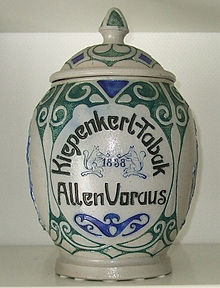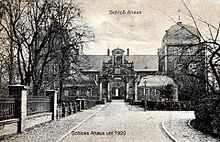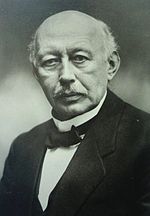Oldenkott (company)
| HENRIC's OLDENKOTT SENIOR & COMP. | |
|---|---|
| legal form | various |
| founding | 1740 |
| Seat | Weesp, Elten, Rees, Anholt, Bingen am Rhein, Düsseldorf, Hanau, Straelen, Amsterdam, Ahaus, Hagen, Neuss, Amsterdam, Cologne |
| Branch | Tobacco processing, pipe production |
| Website | www.henrics-oldenkott.com |
Oldenkott is the name of a family company from the Netherlands that was active in the tobacco product manufacture at several locations from 1740 to 1972 .
history
Up to 1929 there were initially two competing companies Oldenkott, which manufactured tobacco products in the Netherlands and Germany:
Henric's Oldenkott senior & Comp., Rees
Henricus Oldenkott was already producing tobacco products in Weesp in 1740 . The company was later called Henric's Oldenkott senior & Comp. and founded a branch in Elten .
In 1838 the businessman August Kersten from Rees on the Lower Rhine took over the company location in Elten and shares in the main factory in Weesp. Around 1850 Kersten took over further shares in the Weesp plant. He developed the company into one of the largest and most important tobacco companies in Germany. The Kiepenkerl tobacco was traded as tobacco with a worldwide reputation. From 1895, the company had the Kersten family's coat of arms and two smoking squirrels printed on the packaging and registered in court to protect against unfair competition. Until before the First World War , the number of employees remained below 200 people.
In 1921 Henric's Oldenkott sen. & Comp. in Rees one of the most modern tobacco factories in Germany with workshops, its own print shop and siding. In 1923 the company moved to new factory buildings in Melatenweg outside the city center. Between 1924 and 1928 a five-story concrete high-rise was built to store raw tobacco. Residential houses were built for permanent employees and a company-owned savings bank, a health insurance company and a pension fund were established. Further branches were established in Anholt , Bingen am Rhein , Düsseldorf , Hanau and Straelen
Herm's Oldenkott & Sons, Ahaus
In 1760 , Hermannus Oldenkott (* 1730, † 1792) from Vreden founded a tobacco factory in Amsterdam , which developed very successfully and exported to German countries in particular. After his death in 1792 his widow and sons continued the business under the company Herm's Oldenkott & Zoonen in Amsterdam.
In 1819 Hermanus Athanasius Oldenkott, the youngest of the sons, founded a branch in Ahaus to avoid customs problems. He rented the moated castle there and built a tobacco factory in its outbuildings and a side wing. He brought some of the necessary workers with him from Holland. In 1829 the company bought the entire palace building from Prince Salm-Kyrburg and then expanded production considerably.
In 1887 Jakobus Bernardus Oldenkott took over the management of the Ahaus company. He founded a cigar production facility, purchased roasting, sieving and packaging machines, replacing manual labor with mechanical methods. In 1911 he founded a branch for cigar production in Saulgau and the "Westdeutsche Zigarettenfabrik Theodor Oldenkott AG" in Hagen for his son Theodor. Another location, which he entrusted to his son-in-law Josef Bartmann-Oldenkott, son of the factory owner Bernard Bartmann , in 1919 , was built in Neuss .
For advertising purposes, the company published several picture albums from 1900 with rows of Dutch and Swiss city and municipal coats of arms, which were distributed with great success.
The Dutch branch was acquired in 1923 by FM Houbaer & Co., Sigaren- en Cigarillosfabrieken (SOPLA), Amersfoort , and production in Amsterdam was shut down. The Oldenkott brand gradually disappeared in the Netherlands before the Second World War .
Takeover in 1929
In 1929 Henric's Oldenkott sen. & Co. the factories of Herm's Oldenkott & Zoonen in Neuss and Ahaus. The tobacco production in Ahaus was given up. However, Ahaus Castle was used as the residence of the Oldenkott family until it was destroyed in 1945 and sold in 1949.
Herm's Oldenkott & Zoonen's advertising method with picture albums was continued with the release of new albums on topics such as medals, nature and an album "Germany needs colonies" .
In 1932 Oldenkott started in Rees according to Kersten's motto: "For good Oldenkott tobacco the good Oldenkott pipe!" with the production of sophisticated pipes from briar wood . The company also became the leading German manufacturer of pipe tobacco.
During the Second World War, the tobacco factory was partially destroyed and the pipe factory completely destroyed. As early as 1945, pipe production was resumed in other rooms. The product range comprised 60 models and Oldenkott became the market leader in Germany with a 40% market share. The company reached its absolute peak in employment in 1950 with 500 employees. With the advance of the cigarette, pipe production decreased. In 1959 the so-called Piparillo pipe (for short pillar pieces) was brought onto the market.
As a result of the Terry Report of 1964 ( "Cigarette smokers get cancer by pulling their lungs" ) the demand for pipes increased again, so that between 1968 and 1970 there were overtime and long delivery times. With over 40,000 pipes per month and a 70% market share in Germany, Oldenkott became the largest pipe manufacturer in Europe.
End and new beginning
Due to declining tobacco production, a sales cooperation with the Dutch tobacco company Königliche Theodorus Niemeyer BV was established after 1970 . In 1972 the Oldenkott company was sold to Niemeyer. The production of Oldenkott tobacco was discontinued in 1974 and pipe production was reduced. In Rees there were still 36 pipe makers producing 150,000 pipes a year.
In 1987 Peter Kersten bought the company back. However, he did not manage to save the company. In 1991, 16 pipe makers were still producing 58,000 pipes and in 1992 the business had to be closed for economic reasons. In Rees, the statue of a pipe-smoking Kiepenkerls reminds of the great time of the tobacco industry in the place.
In 2012 the rights to the word and figurative mark Henric's Oldenkott Senior & Comp. acquired by Alexander Strähnz, Cologne , with the aim of resuming pipe production, initially on a small scale.
literature
- Dieter Roos: Not just blue haze ...: ... about tobacco, cigars and pipes; the history of tobacco and the tobacco industry, taking into account the manufacture of smoking tobacco, cigars and pipes in Rees. Verlag für Kultur und Technik, Rees 1999, ISBN 3-924637-31-8 .
- Bernd A. Oldenkott: History of the Oldenkotts and their tobacco. In: Ahauser Heimatbrief 2013. Issue 15, ed. from Ahauser Heimatverein 1915 eV, Ahaus 2013.
- Philipp Emming: Oldenkott One of the best pipes in the world. Epubli, 2019, ISBN 978-3-7485-3567-6 .





